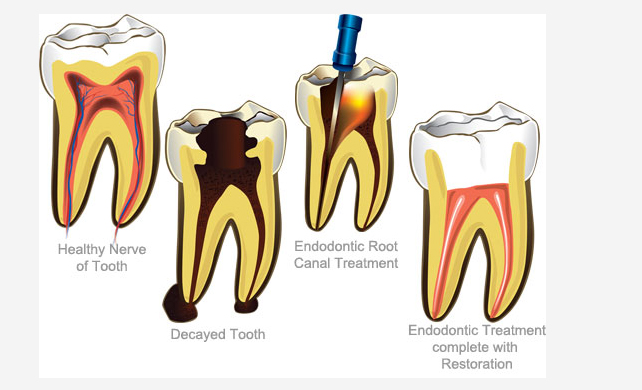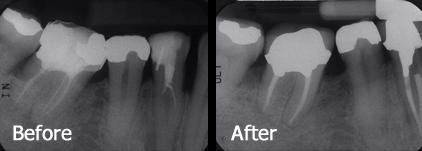Root Canal Therapy
RCT/Endodontic
Root Canal Therapy (RCT) involves the removal of the nerve inside your tooth. This nerve supplies the feeling and sensation to your tooth and once this becomes infected due to a knock, severe decay or fracture then you may experience pain in the area. Root Canal Therapy is a fantastic option to save a tooth that would otherwise require extraction. This procedure is completed over a series of appointments and when the nerve chamber is completely free of debris and nerve tissue we will place an inert material to seal the canal from further infection.

Though root canal therapy has a reputation as a hurtful procedure, in fact it’s designed to relieve the pain and infection caused by an infected tooth. Root canal therapy is a procedure to try and retain a tooth in the mouth when the nerve has died or is dying, restoring the tooth to it’s to be fully functional in the mouth.
Root canal therapy is technically demanding procedure, but once when performed well, has a very high success rate. A root canal is usually a simple procedure with little or no discomfort; most of our patients report that having root canal treatment today is as simple getting a filling.
Root Canal Therapy
Typically root canal therapy is not a painful procedure. In some circumstances when you come in with a lot of pain it may be difficult to alleviate on the first appointment. Root canal treatment is like getting a filling done just over 3-4 visits.
Root canal treatment is usually required when a tooth has been seriously damaged, whether by decay or trauma. The tooth may become painful, when the nerve becomes infected with bacteria as a result as a result of such damage. In these cases root canal therapy cleanses the inside chamber of the tooth that hold the nerve, making it free of the bacteria.Your tooth is then further cleaned and prepared and filled at the subsequent root therapy visits.
After these 3-4 visits or the root canal treatment is finished, the tooth needs a crown over it, this protects the tooth from breaking down and from getting re-infected.

The following are examples for root canal treatment:
- Inflamed Teeth A damaged tooth that has inflammation of the pulp (nerve) can be acutely painful for the patient and can only improve with professional treatment.. How the inflamed will be treated?Treatment is started towards removal of the inflamed tissue, then preparation of the canal systems and full obturation of the root canal, ensuring that, combined with a good crown or filling, bacteria can be prevented from multiplying in the canal spaces. Prognosis in this condition is usually very good and success rates of 96%.
- Infected Teeth The situation can be worse if the nerve or a blood vessel has disintegrated and bacteria have multiplying at the root canal system. This can lead to abscess formation, with the bacteria sending toxins into the jaw bone. How the infected tooth will be treated? Treatment is very demanding where infection is present, as it then involves cleaning the contaminated root canal system of all bacteria. Canals are complex, three-dimensional spaces where absolute sterility will not occur, so the aim of filling of the canals is to trap any remaining bacteria and prevent any nutrients getting to them so that they will no longer be viable.
 Before Infected molar tooth before treatment showing large abscess. After Root canal treated tooth after 3 months, showing bone healing. Even with the most advanced and efficient mechanical equipment, it is impossible to get rid of all the bacteria, so by using various irrigates to further cleanse the canals and increase the chances of a successful first-time treatment, as long as there are no leakage and the tooth is well sealed, a very high success rate can be achieved.
Before Infected molar tooth before treatment showing large abscess. After Root canal treated tooth after 3 months, showing bone healing. Even with the most advanced and efficient mechanical equipment, it is impossible to get rid of all the bacteria, so by using various irrigates to further cleanse the canals and increase the chances of a successful first-time treatment, as long as there are no leakage and the tooth is well sealed, a very high success rate can be achieved. - Re-Treatments If previous root canal treatment has not achieved good results, or the canals/root canal treatment has become reinfected, a further attempt can be made to cleanse the canals and re-treat the tooth. Often it requires the removal of any obstructions or filling of the canal. How the re-treatment could be done? Re-treatment may require post removal and removal of the root filling. The success rates for re-treatment tend to be not quite as good, but a viable alternative to extraction.Before Failed root canal treatments with abscess.
After 6 months after re-treatments, showing bone healing.
- Surgical Treatment Occasionally surgery has to be undertaken to rectify any errors or to clean an inaccessible portion of a tooth. How is this done? With the modern techniques, we often can avoid all surgical treatment by first re-treating the tooth and this is usually our first option. However, there are specific indications for surgery; these include avoiding damage to a new postor crown or if there is an untreated portion of root not amenable to routine cleansing, or a missing root canal which has not been filled, In these cases we perform surgery if it has a good prognosis.In Some cases the patient needs to be referred to specialist/endodontic.








